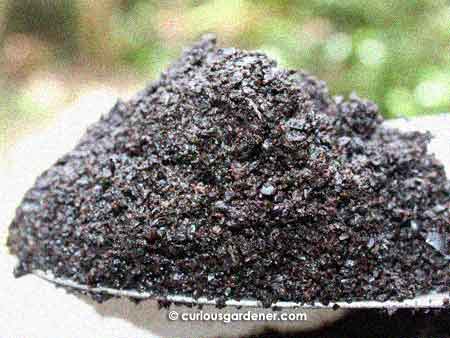I recently got my hands on a load of used coffee grounds, thanks to Growing Like A Weed’s mum, aka The Mother Weed. ![]() Like all companionable gardeners, excess resources have to be shared, you see, so I found myself with the equivalent of about a month’s worth of used coffee grounds if we brewed a big pot of coffee every day…
Like all companionable gardeners, excess resources have to be shared, you see, so I found myself with the equivalent of about a month’s worth of used coffee grounds if we brewed a big pot of coffee every day…
If you do some online research, you’ll learn that coffee places overseas give away their used coffee grounds as part of an attempt to “go green”. Why destine something for a landfill when it can be recycled? Especially when you get good PR out of it from gardeners.
Well, Mother Weed found the local equivalent, and shared her booty of coffee grounds. I knew they can be used in composting, and I’d heard that you can make a “tea” from the used grounds – but since I wasn’t certain, I did some research, just to be sure.
One of the things that takes the fun out of gardening for me is technical jargon – so when articles began to mention pH values and the such, my brain began to glaze over. To put it in terms I can accept easily, coffee grounds are not acidic after they’ve been brewed – the acid is water soluble and is guzzled by us in liquid form, so the grounds left behind are almost pH neutral, more or less.
This means that the grounds can be used:
- to amend soil
- as a lower layer in mulching
- in a compost heap
In composting, the grounds reportedly help to sustain the high temperatures needed to kill off pathogens and seeds in the pile.
Some sources say the grounds can be sprinkled around as-is; others say the grounds have to be composted before they can be used near plants. I decided to sprinkle small amounts as side-dressing to see how my plants would react. Besides that, I’d also read that earthworms like coffee grounds. Well, my plants would definitely benefit from having more worms aerating the soil they grow in, so if the coffee grounds really attract them, then we will definitely keep adding them around the garden.
The grounds can also be used as a tea. Soak them in water for a day or three, letting them steep in the sun, and use that tea to water your plants, or as a foliar spray. I haven’t tried this yet, though.
Coffee grounds reportedly contain nitrogen, phosphorus, calcium, potassium, magnesium and sulphur, which makes them a great source of nutrition for our plants. I will definitely continue using them in the garden, moderately, of course. If anything, you shouldn’t introduce new elements too suddenly in big quantities, otherwise your garden’s ecosystem can be thrown off balance, and your plants may suffer for it. We don’t usually brew a lot of coffee, so this nice injection of the coffee grounds was very welcome. Thank you, Mother Weed!


From the Mother Weed: Anytime, Curious Gardener! My kopi ladies are only too happy not to have to carry the bags of grounds to the garbage collection point. Don’t keep the grounds for too long – a week is enough. I usually tie it up in a bag and pop it into the wheelie bin overnight. Makes the bin smell good.
Makes the garden smell good, too, for a while! Mmmm, coffee…
Strangely enough, some of the people in GCS who’ve used coffee grounds say otherwise to some points you raised. Lol. DG mentioned a few posts down that “his” earthworms hate coffee grounds and all move house when he uses it.
http://www.greenculturesg.com/forum/index.php?/topic/29921-coffee-grounds/
LOL. I guess I’ll find out how the worms here feel about it. And it’s also why I’ve used it in moderation.